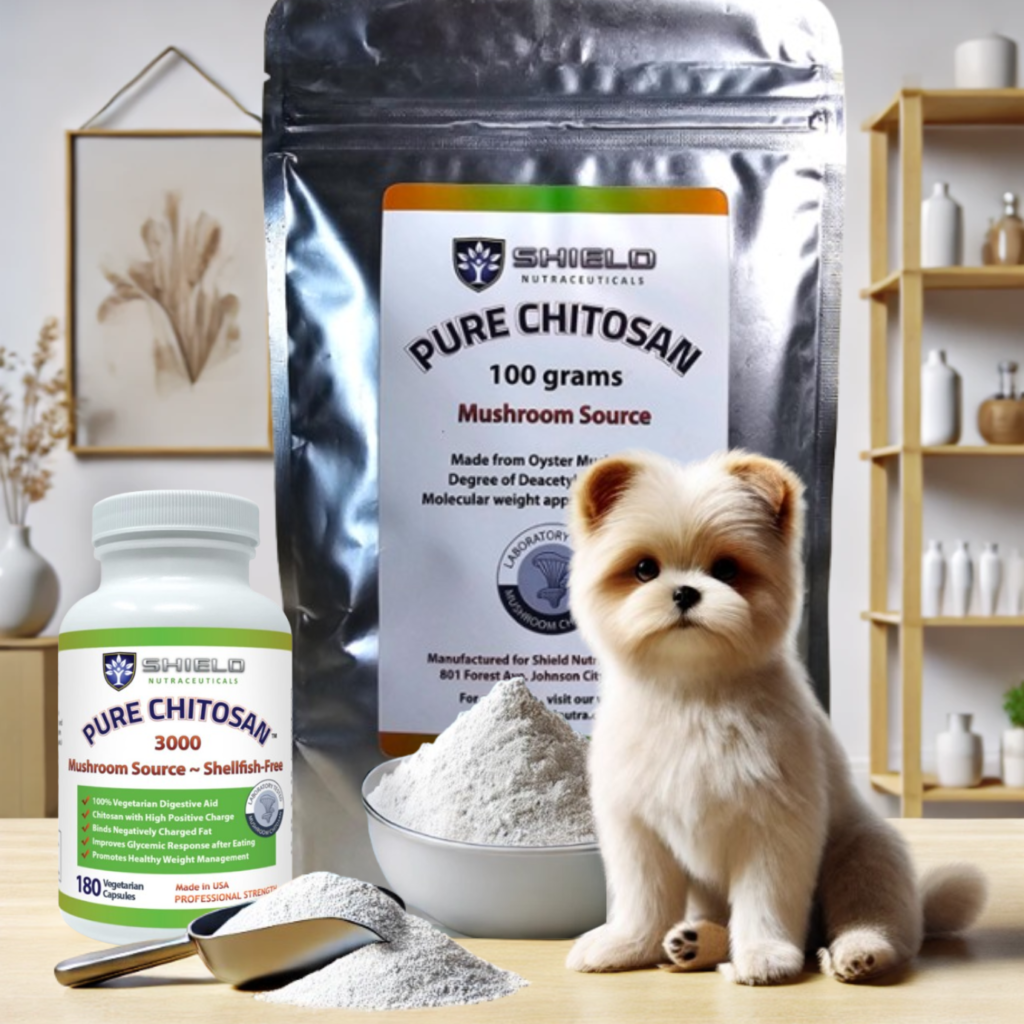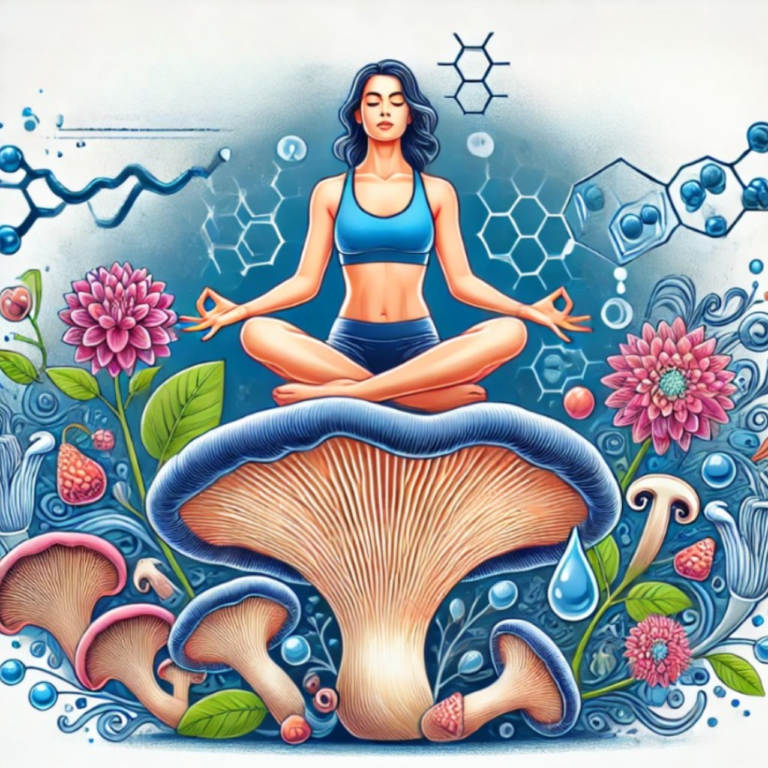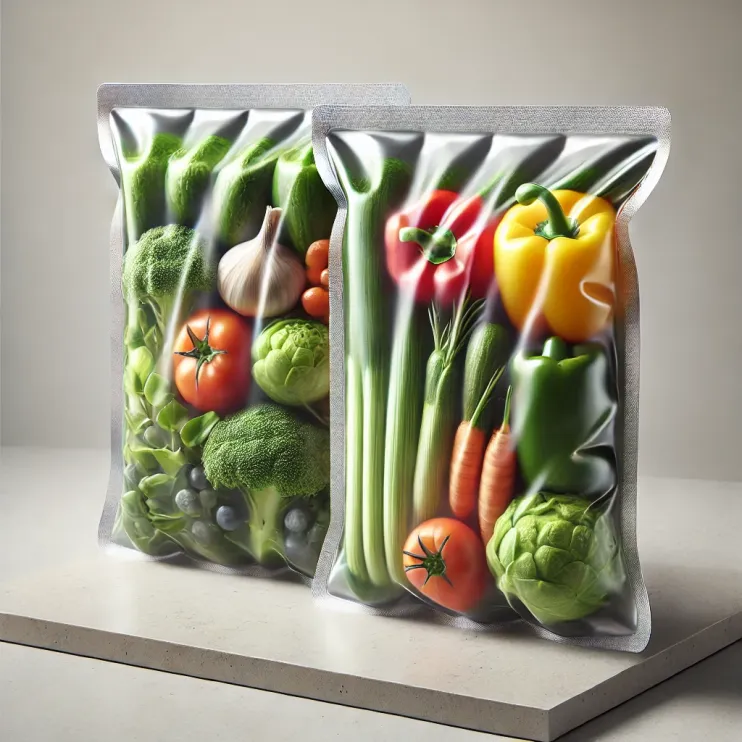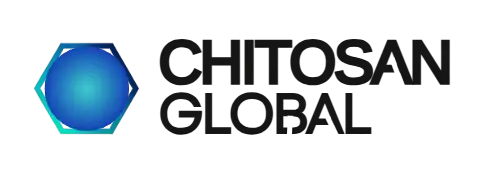Chitosan-A Vital New Ingredient in Novel Dental Care Products

Got Chitosan? Chitosan is a natural biopolymer extracted from the cell walls of fungi and the shells of crustaceans and insects. It’s derived from chitin, a structural component that gives mushrooms their rigidity and form. Origin and Abundance Pronunciation Guide Chemical Structure and Properties Chitosan is obtained through a process called deacetylation of chitin. This involves: This chemical transformation gives chitosan its positive charge, differentiating it from its parent compound, chitin. What are the benefits of using non-shellfish chitosan in dental & oral care? Mushroom chitosan derived from sources like oyster mushrooms, presents several beneficial properties for dental oral care. (We do not recommend EVER putting shellfish-derived chitosan in ANY products that contact humans or animals.) Here’s a list of its functions and benefits: Mushroom Chitosan in Dental/Oral Care Reduction of Dental Plaque and Periodontal Disease: Chitosan’s powerful antibacterial properties make it a formidable ally in the fight against oral health issues. By actively suppressing bacterial growth and breaking down stubborn biofilms, chitosan creates an inhospitable environment for harmful microorganisms in the mouth. This dual-action approach significantly reduces plaque formation on teeth and along the gum line, effectively lowering the risk of periodontal disease development. As a natural defender against oral pathogens, chitosan helps maintain a balanced oral microbiome, preventing the inflammation and tissue damage associated with gum disease. Its ability to penetrate and dismantle existing biofilms also makes chitosan an invaluable tool in combating persistent oral infections, offering a proactive solution for maintaining optimal dental health. Improved Wound Healing: Chitosan, a versatile biopolymer derived from chitin, exhibits remarkable properties that significantly enhance the healing process of oral tissues. Its unique ability to promote tissue regeneration accelerates the recovery of oral abrasions and surgical sites, leading to faster and more effective healing outcomes. This natural compound creates an optimal environment for cell proliferation and tissue repair, reducing inflammation and minimizing the risk of infection. As a result, patients experience quicker recovery times, less discomfort, and improved overall healing of oral wounds and post-surgical areas. The application of chitosan-based materials in dental procedures has thus become increasingly popular, offering promising advancements in oral health care and surgical recovery. Enhanced Efficacy of Oral Hygiene Products: Chitosan’s unique capacity to bind and gradually release therapeutic agents revolutionizes oral care products, significantly enhancing their efficacy. This remarkable property allows for extended protection against harmful oral pathogens, ensuring a longer-lasting defense for dental health. The integration of chitosan into toothpaste formulations is rapidly gaining traction in the dental care industry, with widespread adoption seemingly imminent. Forward-thinking companies are poised to capitalize on this innovation, as the market for chitosan-enhanced oral care products is set to expand dramatically. Savvy businesses should act swiftly to secure their share of this burgeoning market and stay ahead of the curve in dental hygiene advancements. Call us today. Safe and Natural Oral Care: Chitosan’s natural origins and remarkable properties make it an ideal candidate for revolutionizing oral hygiene products. As a biocompatible and biodegradable substance, it offers a safe and eco-friendly alternative to synthetic ingredients commonly found in dental care formulations. This natural polymer significantly reduces the risk of adverse reactions, making it particularly suitable for individuals with sensitive oral tissues or those prone to allergies. By incorporating chitosan into toothpaste, mouthwash, and other oral care products, manufacturers can create gentler yet highly effective solutions that promote optimal oral health without compromising on safety. This shift towards natural, body-friendly ingredients aligns perfectly with the growing consumer demand for safer and more sustainable personal care options. Anti-Inflammatory Properties: Chitosan’s anti-inflammatory properties make it a powerful ally in the fight against gum diseases. This natural compound has shown remarkable efficacy in reducing gum inflammation, offering a promising approach to both treating and preventing conditions such as gingivitis. By incorporating chitosan into oral care routines, individuals can potentially mitigate the swelling, redness, and discomfort associated with inflamed gums. Its ability to soothe irritated tissues and promote healing creates a healthier oral environment, potentially reducing the risk of more severe periodontal issues. As research continues to unveil chitosan’s benefits, it’s becoming increasingly clear that this versatile substance could play a crucial role in maintaining optimal gum health and supporting overall oral well-being. Functions of Mushroom Chitosan in Dental Oral Care Antimicrobial Activity: Chitosan of the proper molecular weight (3kDa) and degree of deacetylation (>98%) inhibit the growth and activity of various pathogens in the oral cavity, helping prevent infections and complications like tooth decay and gum disease. To buy chitosan in bulk at wholesale prices, go HERE Biofilm Disruption: The right derivative of Chitosan can disrupt the structure and formation of bacterial biofilms on dental surfaces, which are a major cause of plaque buildup and cavities. Call us today to discuss the right derivative for your application. Call 423-202-6145. Ask for Steve Nice Carrier for Therapeutic Agents: Chitosan’s versatility extends beyond its inherent benefits, as it excels as a carrier and delivery system for other active ingredients in dental products. This natural polymer creates a synergistic effect, enhancing the stability and potency of various oral care formulations. By encapsulating or binding to other beneficial compounds, chitosan facilitates their controlled release, ensuring a more sustained and targeted delivery within the oral cavity. This unique property allows for improved absorption and prolonged action of active ingredients, maximizing their therapeutic potential. As a result, dental products incorporating chitosan as a delivery medium can achieve greater efficacy, providing users with more comprehensive and long-lasting oral health benefits. This innovative approach to ingredient delivery is revolutionizing the development of advanced dental care solutions. Wound Healing Support: Chitosan’s remarkable ability to accelerate oral tissue healing makes it a valuable asset in post-dental surgery recovery and the treatment of mouth ulcers. This natural biopolymer stimulates and enhances cellular activities crucial for tissue regeneration, creating an optimal environment for rapid healing. By promoting cell proliferation and migration, chitosan helps to rebuild damaged oral tissues more efficiently. Its application can significantly reduce recovery times following dental procedures, alleviating discomfort and minimizing
Mushroom Chitosan in Hair Care: Enhanced Moisture, Strength, and Shine

What is Mushroom Chitosan? Mushroom chitosan is a natural biopolymer extracted from the cell walls of fungi. It’s derived from chitin, a structural component that gives mushrooms their rigidity and form. Origin and Abundance Pronunciation Guide Chemical Structure and Properties Chitosan is obtained through a process called deacetylation of chitin. This involves: This chemical transformation gives chitosan its positive charge, differentiating it from its parent compound, chitin. Uses and Applications: Chitosan, a versatile biopolymer derived from chitin, has found widespread applications across multiple industries due to its unique properties. This biodegradable and non-toxic compound offers a range of benefits in various sectors: The wide-ranging applications of chitosan stem from its unique combination of biocompatibility, biodegradability, non-toxicity and positive electrical charge. Variants: Chitosan’s versatility, biodegradability, and non-toxic nature make it a valuable material across various industries, from healthcare to cosmetics. Its ability to be derived from non-animal sources also makes it an appealing option for vegetarian and vegan-friendly products. What are the advantages of Mushroom Chitosan? Mushroom Chitosan is a type of chitosan derived from the cell walls of fungi. It has several advantages over traditional chitosan derived from shellfish, including: Mushroom chitosan offers several advantages over traditional chitosan, making it an attractive alternative for individuals and industries looking for a vegan, allergen-free, and more effective chitosan source. What are the benefits of chitosan in hair care? Chitosan is a natural biopolymer derived from the structural elements in the cell walls of fungi, making it a vegetarian alternative to traditional chitosan, which is sourced from shellfish. Chitosan and hair are complementary because they carry opposite electrical charges – Chitosan positive and hair negative . A Clear solution that contains chitosan forms a clear, elastic film on hair, increasing its softness and mechanical strength. The material can also form a gel when added to mixtures of alcohol and water. Chitosan acts as an antistatic thereby protecting hair from waving and bleaching agents. It helps to retain moisture in low humidity and to maintain hair’s style in high humidity. The material can be used in shampoos , rinses, permanent wave agents, hair colourants, styling lotions, hair sprays and hair tonics. In hair care products, mushroom chitosan offers several benefits and functions, and its efficacy will depend on the dosage used. Key Benefits of Chitosan in Hair Care: 4. What are the functions of chitosan in hair care? Functions in Hair Care Formulations: What are the recommended dosages of chitosan in hair care formulations? The optimal dosage of mushroom chitosan in hair care products is tailored to achieve specific effects and complement various formulations. Generally, concentrations range from 0.1% to 2%, with lower amounts (0.1% to 1%) typically used in everyday products like shampoos and conditioners. For more intensive treatments or styling products aiming for enhanced film-forming and strengthening properties, higher concentrations of up to 2% may be employed. This flexibility in dosage allows manufacturers to fine-tune the chitosan content to maximize its benefits, whether for basic hair maintenance or more targeted hair care solutions. The precise amount used depends on factors such as the product type, intended effects, and interaction with other ingredients in the formulation. Formulating with Chitosan When formulating hair care products with vegetal chitosan, professionals must navigate several key considerations. Compatibility with other ingredients is crucial, as vegetal chitosan may interact differently than its animal-derived counterpart. pH sensitivity is another critical factor, requiring careful adjustment during product development to maintain chitosan’s efficacy. Notably, mushroom chitosan’s sustainability and ethical sourcing align with growing consumer demands for cruelty-free and eco-friendly options, giving it an edge over marine-sourced alternatives. This versatile ingredient offers multiple benefits in hair care, serving as a moisturizer, protectant, and conditioner. Its natural origin and biocompatibility have made it increasingly popular in both consumer and professional hair care products. However, the optimal dosage and application method vary depending on specific product goals and formulation requirements, necessitating thoughtful development processes to maximize its potential in diverse hair care solutions. Chitosan in hair care applications Non-shellfish-derived chitosan is emerging as a versatile ingredient in hair care, prized for its moisture-binding properties, frizz-reducing capabilities, and ability to enhance hair shine. As a natural film-former, it provides protective and strengthening benefits to hair strands. Typically incorporated at concentrations of 0.1% to 2% in product formulations, chitosan’s effectiveness can be tailored to specific hair care needs. Its eco-friendly profile, stemming from its natural origin and biodegradability, aligns well with the growing demand for sustainable beauty solutions. The future of chitosan in hair care is poised for groundbreaking advancements. Researchers are exploring its potential for deep, molecular-level hair repair and scalp microbiome support, which could revolutionize hair growth and overall scalp health. Chitosan’s unique properties are being harnessed for enhanced drug delivery, improved color retention, and superior protection against heat and environmental damage. The focus on customization and personalization is driving studies into chitosan’s interactions with other natural ingredients, paving the way for tailored hair treatments. Sustainability remains a key concern, with efforts to improve chitosan production methods. Anti-aging applications, including delaying greying and maintaining hair density, are also under investigation. Perhaps most exciting is the use of chitosan in 3D bioprinting for hair follicle regeneration, offering hope for advanced hair loss treatments. These diverse research directions showcase chitosan’s versatility and potential to transform hair care, promising more effective, natural, and personalized solutions for a wide range of hair concerns. Book a Free Consultation If you don’t know what type of chitosan is best for your situation, Book an appointment. we will offer you an initial 30-minute consultation and product quotation at no charge.
Nurturing Pets Naturally with Mushroom Chitosan for Optimal HealthNurturing Pets Naturally: The Benefits of Mushroom Chitosan in Pet Health

1. What is Mushroom Chitosan? Mushroom chitosan is a natural biopolymer extracted from the cell walls of fungi. It’s derived from chitin, a structural component that gives mushrooms their rigidity and form. Origin and Abundance Pronunciation Guide Chemical Structure and Properties Chitosan is obtained through a process called deacetylation of chitin. This involves: This chemical transformation gives chitosan its positive charge, differentiating it from its parent compound, chitin. Uses and Applications: Chitosan, a versatile biopolymer derived from chitin, has found widespread applications across multiple industries due to its unique properties. This biodegradable and non-toxic compound offers a range of benefits in various sectors: The wide-ranging applications of chitosan stem from its unique combination of biocompatibility, biodegradability, and non-toxicity. As research continues, it’s likely that even more uses for this versatile compound will be discovered across various industries. Variants: Chitosan’s versatility, biodegradability, and non-toxic nature make it a valuable material across various industries, from healthcare to cosmetics. Its ability to be derived from non-animal sources also makes it an appealing option for vegetarian and vegan-friendly products. 2. What are the advantages of Mushroom Chitosan? Mushroom Chitosan is a type of chitosan derived from the cell walls of fungi. It has several advantages over traditional chitosan derived from shellfish, including: Overall, mushroom chitosan offers several advantages over traditional chitosan, making it an attractive alternative for individuals and industries looking for a vegan, allergen-free, and more effective chitosan source. 3. What are the benefits, functions and dosage of chitosan for pets? Mushroom chitosan, derived from non-animal sources such as fungi, is increasingly being explored for use in pet food, including for cats, dogs. Its benefits, functions, and recommended dosages in this context vary based on the intended purpose and the type of animal. The addition of pure chitosan powder to pet food at feeding time is as simple as emptying a 500mg capsule into their food once daily. You can obtain 90ct or 180ct Pure Chitosan, 500mg capsules HERE Benefits of Mushroom Chitosan in Pet Food Functions in Pet Dosage for Pets Important Considerations While vegetal chitosan can offer various health benefits for pets, it’s crucial to use it under veterinary guidance to ensure it’s suitable and safe for the specific health needs of the animal. 4. What are the common forms of chitosan used in pet uses? In pet uses, chitosan is utilized in several forms, each suited to different applications based on the needs of the animal. The common forms include: General Considerations The dosage and frequency of chitosan use in pets should be tailored to the individual needs of the pet, keeping in mind factors like size, health conditions, and dietary requirements. When choosing a chitosan product for pets, it’s important to consider the pet’s size, dietary needs, and any specific health concerns. Consultation with a veterinarian is recommended to determine the most suitable form and dosage of chitosan for an individual pet’s requirements. Important Notes Remember, these are just general guidelines and should not replace professional veterinary advice. Each pet is unique, and their health needs can vary greatly. 5. Which type of chitosan is best in pet uses, acid-soluble chitosan, chitosan hydrochloride or chitosan oligosaccharide? Choosing the most suitable type of chitosan for pet uses depends on the specific health needs of the pet and the intended application. Here’s a brief overview of acid-soluble chitosan, chitosan hydrochloride, and chitosan oligosaccharide to help determine which might be better for certain pet uses: Acid-Soluble Chitosan Chitosan Hydrochloride Chitosan Oligosaccharide Conclusion In summary, each type of chitosan has unique properties and potential uses in pet health, and the best choice varies depending on individual pet needs and the specific health benefits being targeted. 6. Mushroom chitosan in pet applications Mushroom chitosan, sourced from fungi, can offer diverse health benefits for pets, including enhancing digestive and immune system health, aiding in weight management, and contributing to joint health. It’s available in various forms like powders, capsules, enriched pet foods, topical applications, and oral hygiene products, catering to different health needs and ease of administration. When used in pet care, the dosage of chitosan varies with the pet’s size and specific health requirements, emphasizing the need for following manufacturer guidelines or consulting a veterinarian. Its use in pets not only supports overall health but also aligns with eco-friendly and sustainable pet care practices. References: Book a Free Consultation If you don’t know what type of chitosan is best for your situation, Book an appointment. we will offer you an initial 30-minute consultation and product quotation at no charge.
Transform Your Diet: How Mushroom Chitosan Promotes Weight Management and Enhances Metabolism

3. What are the benefits, functions of mushroom chitosan in weight-loss? Mushroom chitosan, as opposed to the traditional method from shellfish, offers several benefits and functions that make it a potentially useful aid in weight loss: Benefits of Mushroom Chitosan in weight-loss Functions of Chitosan in weight-loss These functions and benefits show how Chitosan can be an effective adjunct in a weight management plan, particularly when combined with lifestyle changes like diet and exercise. 4. What is the dosage or formula guideline of mushroom chitosan used in weight-loss? The appropriate dosage of vegetal chitosan for weight loss can vary depending on several factors, including the specific formulation of the product, the purity of chitosan used, and individual health conditions. However, I can provide some general guidelines based on available research and typical usage: For the most accurate and personalized advice, it’s best to consult a healthcare professional who can consider personal health status and specific needs. This ensures the supplementation is not only effective but also safe. 5. What is form of vegetal chitosan in weight-loss? Vegetal chitosan for weight loss is available in various forms, each designed to suit different preferences and usage scenarios. Here are the common forms in which vegetal chitosan is typically found as following, along with specific guidelines that can help you choose and use the right form effectively:: General Guidelines: Each form of chitosan may offer different conveniences, which can have advantages in terms of ease of use, portability, and flavor, so your choice might depend on your lifestyle, preferences for intake, and any specific dietary needs. 6. Which type of chitosan is best for weight-loss? Choosing the best type of chitosan for weight loss depends on specific needs and health goals. Each type of chitosan—acid-soluble chitosan, chitosan hydrochloride, chitosan oligosaccharide, and carboxymethyl chitosan—offers distinct advantages that can contribute to weight management in different ways: Consideration: The selection ultimately depends on personal health goals, any existing dietary restrictions, and how well one’s body tolerates chitosan. Consulting with a healthcare provider can provide further guidance tailored to individual health profiles and dietary needs. In addition, based on the years’ market feedbacks, acid-soluble chitosan is more commonly used in capsule form as a fat binder for weight loss in the market. This traditional form of chitosan is favored for several reasons: While acid-soluble chitosan is effective as a fat binder, it’s worth noting that other forms of chitosan, especially water-soluble types like chitosan hydrochloride, are gaining attention for their enhanced solubility and potentially broader range of biological effects. However, in terms of market dominance for the specific application of weight loss through fat binding, acid-soluble chitosan in capsule form remains highly popular. 7. What is the working mechanism of mushroom chitosan in weight-loss? Mushroom chitosan works through several mechanisms to aid in weight loss, primarily by interacting with dietary fats and affecting metabolic processes. Here’s a detailed look at how vegetal chitosan functions: These diverse mechanisms make vegetal chitosan a multi-functional agent in weight loss supplements, capable of affecting both the intake and digestion of dietary fats, as well as influencing overall metabolic health. 8. Chitosan’s emerging role as a carrier of GLP-1 gene therapy Based on the study research: https://pubmed.ncbi.nlm.nih.gov/21412280/, it focuses on the development and characterization of a chitosan-based nanoparticle for the delivery of GLP-1 (glucagon-like peptide-1) gene therapy. GLP-1 is a hormone involved in glucose regulation and appetite control, making it a promising target for treating obesity. This research explores the potential of chitosan as a carrier for gene therapy aimed at enhancing the body’s production of GLP-1, which could theoretically aid in weight loss and improve glucose homeostasis. Effectiveness of Chitosan in Gene Delivery: Chitosan’s natural properties make it an attractive candidate for gene delivery systems: The specific study on the chitosan-based delivery system for the GLP-1 gene shows that this approach could potentially enhance the therapeutic effects of GLP-1, such as improved blood glucose control and reduced appetite, both key components in managing obesity. Safety of Chitosan in Gene Delivery: While chitosan is generally considered safe and has been used in various biomedical applications, the safety of a chitosan-based gene delivery system specifically for delivering the GLP-1 gene would need thorough evaluation in clinical trials. Here are a few considerations: Discussion: Based on the properties of chitosan and the preliminary research into its use for GLP-1 gene delivery, there is potential for this approach in treating obesity. However, whether this is effective and safe for widespread clinical use will depend on the outcomes of detailed clinical trials designed to rigorously evaluate its therapeutic benefits and potential risks. The concept is promising, but more research is necessary to move from experimental stages to practical medical applications. 9. Chitosan in weight-loss Mushroom chitosan offers a multifaceted approach to weight loss. Its primary function is fat binding, where it interacts with dietary fats in the stomach to form large complexes that the body cannot absorb, effectively reducing the total caloric intake from fats. For this to happen at an optimal level, 6x adsorptive capacity, the chitosan must be highly deacetylated, a minimum of 98% and should have an ultra-low molecular weight of 3000 Daltons. This mechanism not only aids in direct weight loss but also helps in managing blood cholesterol levels, contributing to overall cardiovascular health. Additionally, mushroom chitosan may enhance feelings of fullness and slow down digestion, which can lead to a decrease in overall calorie consumption by suppressing appetite. Mushroom chitosan has been shown to improve gastrointestinal health due to its fiber-like properties, which can promote regularity and improve nutrient absorption. It may also assist in stabilizing blood sugar levels, which helps in managing insulin response and preventing sudden spikes in hunger. The diverse functionalities of mushroom chitosan, including its ability to bind toxins and potentially lower cholesterol, make it a versatile and beneficial supplement for those looking to manage their weight effectively. Its natural origin and the absence of significant side effects commonly associated with synthetic drugs further enhance its appeal as a
Mushroom Chitosan in Textiles: Eco-Friendly Functional Fabric Technology

1. What is Mushroom Chitosan? Mushroom chitosan is a natural biopolymer extracted from the cell walls of fungi. It’s derived from chitin, a structural component that gives mushrooms their rigidity and form. Origin and Abundance Pronunciation Guide Chemical Structure and Properties Chitosan is obtained through a process called deacetylation of chitin. This involves: This chemical transformation gives chitosan its positive charge, differentiating it from its parent compound, chitin. Uses and Applications: Chitosan, a versatile biopolymer derived from chitin, has found widespread applications across multiple industries due to its unique properties. This biodegradable and non-toxic compound offers a range of benefits in various sectors: The wide-ranging applications of chitosan stem from its unique combination of biocompatibility, biodegradability, and non-toxicity. As research continues, it’s likely that even more uses for this versatile compound will be discovered across various industries. Variants: Chitosan’s versatility, biodegradability, and non-toxic nature make it a valuable material across various industries, from healthcare to cosmetics. Its ability to be derived from non-animal sources also makes it an appealing option for vegetarian and vegan-friendly products. 2. What are the advantages of Mushroom Chitosan? Mushroom Chitosan is a type of chitosan derived from the cell walls of fungi. It has several advantages over traditional chitosan derived from shellfish, including: Overall, mushroom chitosan offers several advantages over traditional chitosan, making it an attractive alternative for individuals and industries looking for a vegan, allergen-free, and more effective chitosan source. 3. What are the benefits & functions of chitosan in textile uses? Chitosan, derived from sources such as mushrooms & aspergillus niger, offers several benefits and functions when applied in textiles: Benefits of Mushroom Chitosan in Textiles: Green Footprint: The use of chitosan contributes to the overall ecological footprint reduction of textile production, supporting industry shifts toward greener and more responsible manufacturing methods. Non-Toxicity: Unlike many chemical additives, chitosan is non-toxic, making it safe for use in a wide range of textile applications, including those that come into close contact with skin. Biocompatibility: Its inherent biocompatibility makes it particularly valuable in medical textiles, where it poses minimal risk of skin irritation or allergic reactions, a crucial factor in healthcare-related fabric applications. Functions of Chitosan in Textiles: Antimicrobial Properties: Chitosan’s antimicrobial properties are pivotal in inhibiting microbial growth, making it ideal for hygiene-critical applications such as medical textiles, sportswear, and inner-wear. This function is vital for maintaining sanitary conditions and preventing odor buildup in fabrics. Moisture Absorption and Breathability: Its ability to absorb moisture enhances fabric breathability and comfort, especially in apparel textiles where moisture control is essential for wearer comfort. Strength and Durability: The incorporation of chitosan can bolster the mechanical strength and durability of textiles, thus extending the lifespan and wearability of the fabric. UV Protection: Chitosan-treated textiles offer a shield against harmful ultraviolet rays, adding a layer of protection that is especially beneficial in outdoor and sun-exposed garments. Wound Healing (in Medical Textiles): Leveraging its wound healing capabilities, chitosan is invaluable in medical textiles, promoting healing processes in wound dressings and other medical fabrics. Odor Resistance: Reduces odors in textiles, making them more pleasant to wear. Water Treatment: Beyond traditional textiles, chitosan-coated fabrics can be utilized in innovative water treatment applications, exploiting its ability to bind with heavy metals and pollutants, offering a novel approach to water purification. Flame Retardancy: Incorporating chitosan imparts flame-retardant properties to textiles, an essential function for safety in various applications, including upholstery, draperies, and protective clothing. Static Resistance: In synthetic fabrics, chitosan can help reduce static build-up, enhancing comfort and usability in diverse textile products. Mushroom chitosan plays a multifaceted role in the textile industry. Its benefits extend from enhancing environmental sustainability and safety to improving the functional properties of fabrics. Its versatility and eco-friendly profile make it an increasingly popular choice in the ongoing evolution of textile technology and sustainable practices. 4. What are the common forms of mushroom chitosan used in textile uses? In the textile industry, chitosan is utilized in several common forms, each catering to specific functionalities and applications, with provided specific dosage suggestions for each form of chitosan in textile applications: Fiber Form: Chitosan fibers are directly woven or blended with other natural or synthetic fibers to create composite fabrics. This integration imparts chitosan’s unique properties, such as antimicrobial and moisture-wicking abilities, directly into the fabric structure. When chitosan is integrated into fibers, the concentration can vary significantly. A common ratio might be anywhere from 5% to 30% of chitosan blended with other fibers. The exact ratio depends on the desired properties and the compatibility with other fibers. Powder Form: As a fine powder, chitosan can be applied to textiles through various finishing processes. The powder form is particularly useful for treatments that require a more surface-level application, enabling easy integration with other textile finishing chemicals. For powder application, the dosage can vary from 1% to 5% by weight of the fabric, depending on the desired effect. Higher concentrations generally provide more pronounced antimicrobial and durability effects. Solution or Liquid Form: Chitosan is often dissolved in a liquid medium (usually in acetic acid or other solvents) to create a solution. This chitosan solution can be applied to textiles through techniques like padding, spraying, or coating. This method is especially effective for treatments aiming to provide a thin, even coating over the fabric, useful for antimicrobial finishes or UV protection. In solution form, chitosan is often used in concentrations ranging from 0.5% to 2% (w/v). The exact concentration depends on the method of application (e.g., padding, spraying) and the desired finish. Gel Form: In some applications, chitosan is used in a gel-like form, which is suitable for coating or impregnating textiles. This form is particularly beneficial for medical textiles, where a more substantial layer of chitosan can aid in wound healing and antibacterial properties. Gel applications, particularly in medical textiles, can vary widely in concentration. Typically, a gel containing 1% to 3% chitosan might be used, but this can be
Chitosan Flocculant for Wine, Beer and Whiskey
Mushroom chitosan has been shown to have several benefits when used in winemaking. It can improve the clarity and stability of wine, as well as reduce the levels of unwanted compounds and off-flavors. Mushroom chitosan can also act as a natural preservative, which can extend the shelf life of wine and reduce the need for synthetic additives. (1) Mushroom chitosan can remove undesirable compounds in wine One of the main advantages of mushroom chitosan is its ability to bind with and remove undesirable compounds, such as proteins, tannins, and phenolics from wine. This can help to reduce the risk of haze formation and improve the clarity and brightness of the wine. Moreover, mushroom chitosan can help to reduce the levels of sulfites, which are commonly used as preservatives in wine and can cause allergic reactions in some individuals. (2) Mushroom chitosan can improve the stability of wine Mushroom chitosan can also improve the stability of wine by reducing the risk of precipitation and sedimentation. This can help to prevent the loss of flavor and aroma compounds and ensure the quality of the wine over time. Moreover, mushroom chitosan can act as a natural antioxidant, which can help to protect against oxidative damage and maintain the freshness and flavor of the wine. (3) Mushroom Chitosan can be used as a fining and stabilizing agent, eliminating Brettanomyces It is used as a fining agent in the treatment of musts for flotation clarification to reduce cloudiness and the content of unstable colloids.It is also used for stabilizing wines. This polymer helps eliminate undesirable micro-organisms such as Brettanomyces. 1 (4) Mushroom chitosan can promote sustainability & reduce environmental impact Furthermore, the use of mushroom chitosan in winemaking promotes sustainability and reduces the environmental impact of wine production. Unlike animal-derived chitosan, which is obtained from crustacean shells and can contribute to waste and pollution, mushroom chitosan is derived from sustainable and renewable sources, such as fungi and plants. Moreover, chitosan is biodegradable and does not accumulate in the environment, making it a safe and sustainable solution for winemaking. The use of mushroom chitosan in wine applications has been extensively studied, and the results have shown its effectiveness and safety. (5) Mushroom chitosan has no affect taste aroma or color of wine Mushroom chitosan has been approved by regulatory agencies, such as the European Union and the United States Food and Drug Administration, as a safe and effective additive in winemaking. Moreover, mushroom chitosan has been shown to have no adverse effects on the sensory properties of wine, as it does not affect the taste, aroma, or color of the wine. Mushroom chitosan is an effective and sustainable solution for wine applications. Its unique properties, such as detritus removal, stability enhancement, and natural preservation, make it an attractive alternative to animal-derived additives. Moreover, the use of mushroom chitosan promotes sustainability and reduces the environmental impact of wine production. Therefore, it is expected that the use of mushroom chitosan will continue to grow in the wine industry as a safe and sustainable additive. What is the dosage of chitosan in wine, beer and whiskey? The dosage of chitosan used in clarification will vary by application. In wine, chitosan is often used as a fining agent to clarify the wine by removing unwanted particles such as sediment and haze. The dosage of chitosan in wine can vary depending on the wine’s characteristics and the desired level of clarification. Typically, a dosage of 5 to 100 grams per hectoliter (100 liters) of wine is used, but it is important to follow the manufacturer’s instructions and to conduct trials before use to determine the optimal dosage. In beverages such as juices, ciders and soft drinks, vegetal chitosan is often used as a stabilizer and thickener. The dosage of vegetal chitosan in these beverages can vary depending on the specific product and the desired texture and stability. In general, a dosage of 10 grams per hectoliter (100 liters) is used, but it is also important to follow the manufacturer’s instructions and to conduct trials before use to determine the optimal dosage. In alcoholic drinks such as beer and spirits, chitosan can be used as a clarifying agent to remove unwanted particles and haze. The dosage of vegetal chitosan in these drinks can vary depending on the specific product and the desired level of clarification. Typically, a dosage of 10 to 100 grams per hectoliter of beer is used, but it is important to follow the manufacturer’s instructions and to conduct trials before use to determine the optimal dosage. It’s important to note that the dosage of chitosan can vary depending on the specific product and the desired results, and it’s always recommended to consult the manufacturer’s instructions and conduct trials before use to determine the optimal dosage for your particular application. More information about chitosan to control Brettanomyces Bruxellensis (1) What is Brettanomyces Bruxellensis? In the wine industry, B. bruxellensis is generally considered a spoilage yeast and it and other members of the genus are often referred to as Brettanomyces (“brett”). Its metabolic products can impart “sweaty saddle leather”, “barnyard”, “burnt plastic” or “band-aid” aromas to wine. Some winemakers in France, and occasionally elsewhere, consider it a desirable addition to wine. Some vintners consider brett to be responsible for 90% of the spoilage problems in premium red wines. This undesirable yeast is able to develop during aging under difficult conditions. Development of this microorganism usually results in the production of off-flavors, such as ethylphenols and vinylphenols. In fact, the sensory properties of these molecules (mousiness, animal, horsy, barnyard, smoky, spicy, burnt plastic, or medicinal) are often described as the Brett character. It is also responsible for the production of other negative aromatic compounds such as isovaleric acid (known to be related to unpleasant cheesy aroma) and tetrahydropyridines, responsible for mousy taint. Nowadays at an international scale, volumes concerned by this defect become significant, and Brettanomyces bruxellensis is considered as the major microbial cause for wine spoilage worldwide, causing significant economic losses. Brettanomyces bruxellensis is well adapted to winemaking
Chitosan: A Revolutionary Natural Food Ingredient

1. What is Mushroom Chitosan? Mushroom chitosan is a natural biopolymer extracted from the cell walls of fungi. It’s derived from chitin, a structural component that gives mushrooms their rigidity and form. Origin and Abundance Pronunciation Guide Chemical Structure and Properties Chitosan is obtained through a process called deacetylation of chitin. This involves: This chemical transformation gives chitosan its positive charge, differentiating it from its parent compound, chitin. Uses and Applications: Chitosan, a versatile biopolymer derived from chitin, has found widespread applications across multiple industries due to its unique properties. This biodegradable and non-toxic compound offers a range of benefits in various sectors: The wide-ranging applications of chitosan stem from its unique combination of biocompatibility, biodegradability, and non-toxicity. As research continues, it’s likely that even more uses for this versatile compound will be discovered across various industries. Variants: Chitosan’s versatility, biodegradability, and non-toxic nature make it a valuable material across various industries, from healthcare to cosmetics. Its ability to be derived from non-animal sources also makes it an appealing option for vegetarian and vegan-friendly products. 2. What are the advantages of Mushroom Chitosan? Mushroom Chitosan is a type of chitosan derived from the cell walls of fungi. It has several advantages over traditional chitosan derived from shellfish, including: Overall, mushroom chitosan offers several advantages over traditional chitosan, making it an attractive alternative for individuals and industries looking for a vegan, allergen-free, and more effective chitosan source. Key Advantages of Mushroom Chitosan in Food Applications Sustainable and Multifunctional Mushroom chitosan’s unique structure confers properties of biodegradability, biocompatibility, and non-toxicity. Its ability to form films and gels makes it an excellent agent for enhancing both the quality and longevity of various food products. The presence of two distinct reactive functional groups (an amino group at C2, and a primary and secondary hydroxyl group at C3 and C6) of chitosan are involved in the transformation of expedient derivatives such as acylated, alkylated, carboxylated, quaternized and esterified chitosan. Meeting Modern Food Industry Needs As the food industry increasingly focuses on sustainability, natural ingredients, and enhanced food safety, mushroom chitosan emerges as a versatile solution. It not only addresses these concerns but also offers functional benefits that can improve product quality and consumer appeal. 1. What are the benefits of mushroom chitosan in food applications? Mushroom chitosan represents a significant advancement in the field of biopolymers, emerging as a sustainable and effective alternative to traditional shellfish-derived chitosan. Extracted from the cell walls of fungi, mushroom chitosan offers unique properties that make it ideal for various applications, particularly in the food industry. The unique structure and properties of mushroom chitosan contribute to its numerous benefits, including biodegradability, biocompatibility, and non-toxicity. Its ability to form films and gels makes it an excellent agent for enhancing the quality and shelf-life of various food products. Mushroom chitosan a variety of benefits for food applications, including: (1)Food Preservation and Shelf Life Extension: Mushroom chitosan has excellent antimicrobial properties, making it effective against a wide range of food spoilage organisms and pathogens such as Botrytis Cinerea. This helps in extending the shelf life of perishable food items like fruits, vegetables, and meats. 1 (2)Food Safety: By inhibiting the growth of harmful microorganisms, mushroom chitosan enhances the safety of food products. This is particularly significant in mitigating the risk of foodborne illnesses. (3)Enhancement of Food Quality: It can be used to maintain or enhance the quality of food products. For instance, it can help in retaining moisture, preserving texture, and maintaining the nutritional value of foods. (4)Food Coatings: Mushroom chitosan can form thin, biodegradable films that can be used as coatings for various food items. These films act as barriers to oxygen, moisture, and microbial contamination, further contributing to food preservation. (5)Natural and Sustainable: Being derived from a vegetable source, it is an attractive alternative for those seeking sustainable and eco-friendly food processing aids. It aligns with the increasing consumer demand for natural and plant-based food additives. (6)Food Processing Aid: It can be used as a flocculant in the clarification of beverages, like juices and wines, helping to remove unwanted particles and improve clarity and quality. (7)Reducing Allergenicity and Enhancing Functional Properties: For products like plant-based meats or cultivated meat, mushroom chitosan can help in improving texture and binding ingredients together, while potentially reducing allergenicity compared to shellfish-based chitosan. (8)Control of Fat Absorption: In fried foods, coatings with chitosan can reduce the absorption of oil, leading to lower-calorie products. (9)Regulatory Acceptance: With increasing scrutiny on food additives, mushroom chitosan, particularly because of its natural origin, might face fewer regulatory hurdles compared to shellfish-derived chitosan. These benefits make mushroom chitosan a highly versatile and valuable component in the food industry, contributing not only to the safety and quality of food products but also aligning with the growing trends towards sustainability and natural ingredients. 2. What is the dosage recommendation of mushroom chitosan in food? Determining the optimal dosage of mushroom chitosan depends on the specific application and desired outcome. Generally, concentrations range from 0.5 to 2.0% (w/v), but specific applications may require tailored concentrations. Adherence to regulatory guidelines and safety assessments is crucial in determining the appropriate dosage. Generally, a 1% concentration will kill most pathogenic bacteria. Mushroom Chitosan in food applications: Mushroom chitosan is a versatile and sustainable biopolymer offering considerable benefits in the food industry. Its properties, including biodegradability, antimicrobial activity, and ability to form films, make it a valuable tool in food preservation, processing, and packaging. As the demand for environmentally friendly and safe food processing aids grows, mushroom chitosan stands out as a promising solution. Book a Free Consultation If you don’t know what type of chitosan is best for your situation, Book an appointment. we will offer you an initial 30-minute consultation and product quotation at no charge.
